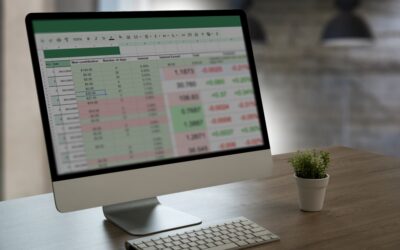Technological advancements have continually reshaped the landscape of business operations, cost structures, and long-term planning. The latest disruption comes from the increasing use of artificial intelligence (AI) algorithms in stock trading. These algorithms are not merely speeding up transactions; they are fundamentally altering how trading strategies are devised, how risks are managed, and how decisions are made at the highest levels of corporate governance.
As AI becomes an indispensable tool in financial markets, businesses need to recognize the profound implications it holds for broader operational efficiency, cost control, and future financial sustainability. This article explores how AI-powered stock trading is reshaping the financial landscape and what it means for decision-makers concerned with corporate strategy, finance, and operations.
The Rise of AI in Stock Trading: A New Frontier in Financial Markets
AI algorithms have steadily made inroads into stock trading, disrupting traditional models and leading to the rise of high-frequency trading (HFT), robo-advisors, and algorithm-driven hedge funds. Historically, stock trading was a realm dominated by human expertise, where analysts pored over balance sheets, charts, and trends to predict market movements. Today, AI is augmenting—and in many cases replacing—human decision-making with data-driven precision.
AI algorithms can process vast datasets at speeds far beyond human capability, detecting patterns and anomalies that traders would likely miss. These systems are not only reactive; they can predict future market movements based on historical data and real-time analysis. The implications of this shift extend beyond trading itself, offering valuable lessons in operational efficiency and strategic foresight for businesses across industries.
Strategic Implications for Corporate Finance and Operations
The adoption of AI in stock trading offers valuable insights for corporate leaders on how technology can be leveraged to improve business efficiency and reduce costs. The ability of AI algorithms to analyze massive amounts of data in real-time and execute decisions instantaneously mirrors the potential benefits AI could bring to other areas of business operations.
For instance, businesses could apply similar data-processing capabilities to supply chain management, optimizing inventory levels based on real-time demand fluctuations, or to customer service, improving response times and satisfaction through AI-driven chatbots. Just as AI has reduced the time it takes to execute trades, it can also shorten decision-making cycles in other operational areas, leading to more agile and responsive organizations.
Key Benefits of AI-Driven Trading Systems
While the immediate benefit of AI in stock trading is the speed and accuracy of transactions, the broader implications lie in the potential for cost reductions and risk management. Here are a few key benefits businesses should consider:
- Reduced Operational Costs: AI-driven systems can execute thousands of trades in milliseconds, significantly reducing transaction costs. For businesses, this translates into more efficient resource allocation, whether applied to finance, marketing, or product development.
- Improved Risk Management: AI can analyze market risks in real time, adapting strategies as conditions change. This capacity to dynamically adjust risk exposure is crucial for businesses aiming to navigate volatile environments without compromising their financial health.
- Predictive Insights: AI’s ability to predict market trends extends beyond finance, offering predictive analytics that can guide decision-making across industries. From predicting customer demand to anticipating supply chain disruptions, businesses can use AI to stay ahead of the curve.
Transforming Financial Planning: The Long-Term Impact of AI
Long-term financial planning has always been fraught with uncertainty. Predicting future revenues, costs, and market conditions involves inherent risks that can make or break a company. The integration of AI into stock trading offers a roadmap for reducing uncertainty in financial planning, enabling more accurate forecasting and better allocation of resources.
AI’s Role in Forecasting and Predictive Analytics
AI algorithms in stock trading are primarily designed to predict price movements based on historical data, real-time news, and market sentiment. This predictive power can be harnessed by businesses to forecast market conditions and consumer behavior more accurately, allowing for more precise budgeting and strategic planning. Companies that can effectively use AI to anticipate market trends and customer preferences are better positioned to maintain a competitive edge.
For example, businesses can apply AI to financial modeling, using real-time data to refine cash flow projections, identify potential cost savings, and optimize investment strategies. In the same way that AI anticipates stock price movements, it can predict shifts in consumer behavior, supplier costs, and even regulatory changes, helping businesses prepare for future challenges.
Enhancing Financial Decision-Making with AI
Corporate decision-makers stand to benefit immensely from AI’s ability to process data at scale and generate actionable insights. One of the key advantages of AI in stock trading is its capacity to remove emotional bias from trading decisions—a feature that holds significant potential for broader financial decision-making.
AI-powered decision models can offer data-driven insights free from the cognitive biases that often cloud human judgment. This is particularly valuable when making high-stakes decisions about mergers and acquisitions, capital allocation, and long-term investments. By relying on AI to provide objective, real-time analysis, companies can reduce the likelihood of costly errors and make more informed decisions that align with their long-term financial goals.
Operational Efficiency and Cost Structures: Lessons from AI in Trading
The operational efficiency AI brings to stock trading offers critical lessons for businesses seeking to streamline their own operations. By automating complex processes and reducing the need for human intervention, AI can significantly lower operational costs while enhancing performance.
Automation and Scalability
AI algorithms allow stock trading firms to scale their operations without a corresponding increase in human capital. This scalability is a model that other industries can adopt to improve operational efficiency. For example, in manufacturing, AI-driven robotics can optimize production lines, reduce waste, and increase output, all while minimizing labor costs. In customer service, AI chatbots and virtual assistants can handle routine inquiries at scale, freeing up human employees to focus on higher-value tasks.
Optimizing Cost Structures
AI-driven stock trading systems offer businesses a blueprint for optimizing their cost structures. The use of AI to reduce trading fees and operational expenses can be replicated in various industries. Whether through automation, predictive analytics, or improved decision-making, AI enables companies to lower costs while maintaining high levels of performance. In sectors such as logistics, healthcare, and retail, the application of AI could lead to significant cost savings by streamlining operations and improving resource allocation.
Emerging Trends in AI-Driven Finance: What’s Next?
As AI continues to evolve, its role in finance will likely expand beyond stock trading to encompass a wide range of financial services. Several emerging trends offer a glimpse into the future of AI-driven finance and its broader implications for corporate strategy and operations.
1. AI-Enhanced Portfolio Management
AI’s ability to analyze vast amounts of financial data has led to the development of AI-driven portfolio management tools that can automatically adjust asset allocations based on market conditions and investment goals. This trend is likely to expand, with businesses using AI to optimize their financial portfolios, balancing risk and return in real-time.
2. AI in Regulatory Compliance
The financial industry is subject to complex regulatory requirements that are costly and time-consuming to manage. AI is increasingly being used to streamline compliance processes by automating the monitoring of transactions and identifying potential violations in real time. For businesses operating in highly regulated industries, AI offers the potential to reduce compliance costs and mitigate the risk of regulatory fines.
3. Ethical AI in Finance
As AI’s influence grows, questions around its ethical use in finance are becoming increasingly important. AI-driven trading systems have the potential to create market instability if not properly regulated. Corporate leaders will need to navigate the ethical challenges of AI adoption, ensuring that their use of AI aligns with broader social and governance standards.
4. AI and Environmental, Social, and Governance (ESG) Investing
AI is also playing a growing role in ESG investing, where environmental, social, and governance factors are considered alongside financial performance. AI algorithms can assess companies’ ESG metrics more accurately, helping investors make informed decisions about where to allocate capital. For businesses, this underscores the importance of incorporating ESG considerations into their strategies, as AI will increasingly hold them accountable to these metrics.
The Strategic Implications of AI in Stock Trading
The rise of AI algorithms in stock trading is more than just a technological shift—it represents a fundamental change in how decisions are made, risks are managed, and resources are allocated across the business landscape. For corporate leaders focused on strategy, finance, and operations, AI’s impact on stock trading offers valuable lessons in efficiency, cost reduction, and long-term planning.
By leveraging AI’s predictive power, businesses can enhance their decision-making processes, improve their operational efficiency, and optimize their financial planning. The future of AI-driven finance is bright, and those companies that can adapt to this new reality will be well-positioned to thrive in a rapidly changing business environment.
In conclusion, while AI is transforming stock trading, its broader implications stretch far beyond financial markets. The lessons learned from AI’s success in this arena can be applied across industries, providing corporate leaders with the tools they need to navigate the complexities of the modern business world, maintain competitive advantage, and ensure financial sustainability for years to come.
AI-Driven Trading and Market Volatility: Navigating Risks in 2024
As AI algorithms continue to dominate stock trading, their impact on market volatility is an increasingly important consideration for businesses in 2024. While AI-driven trading systems provide numerous benefits—such as speed, efficiency, and predictive capabilities—there is growing concern about their role in exacerbating sudden market fluctuations. The flash crash of 2010, for example, demonstrated how algorithmic trading could amplify short-term market volatility, leading to dramatic swings in stock prices within minutes.
In 2024, this issue remains highly relevant as AI algorithms become more sophisticated and prevalent in global financial markets. The increased use of AI-driven trading platforms—particularly high-frequency trading (HFT) systems—introduces new risks for businesses, including the potential for rapid market shifts that can impact corporate finances and investment portfolios.
The Role of High-Frequency Trading in Market Dynamics
High-frequency trading refers to the use of powerful algorithms to execute thousands of trades within milliseconds, capitalizing on tiny price discrepancies. While HFT can enhance market liquidity by facilitating a high volume of transactions, it can also lead to sharp, short-term volatility. In 2024, HFT continues to account for a significant portion of trading activity on major exchanges, making its impact on market dynamics impossible to ignore.
One of the key risks associated with HFT is the “herding effect,” where multiple algorithms react to the same market signals simultaneously, amplifying price movements and triggering sudden market drops or surges. This phenomenon can create challenges for businesses engaged in long-term financial planning, as their investment portfolios may be exposed to abrupt market movements driven by algorithmic trading.
Mitigating the Risks of AI-Driven Volatility
To mitigate the risks associated with AI-driven volatility, businesses in 2024 are increasingly turning to risk management strategies that leverage AI’s predictive capabilities. AI-powered risk management systems can analyze real-time market data and identify patterns of instability before they materialize into full-blown crises. This allows businesses to take proactive measures—such as adjusting their asset allocations or hedging their investments—to minimize the impact of sudden market fluctuations.
Furthermore, companies are adopting AI-enhanced portfolio diversification strategies to reduce their exposure to highly volatile assets. By diversifying across asset classes, geographic regions, and industries, businesses can protect their financial health from the risks posed by AI-driven market dynamics. These strategies are particularly important for firms with significant exposure to financial markets, as they help ensure that AI-driven volatility does not compromise long-term financial sustainability.
AI and Behavioral Finance: A New Frontier in 2024
One of the most intriguing developments in 2024 is the intersection of AI and behavioral finance—a field that studies how psychological factors influence financial decision-making. Traditional stock trading models are built on the assumption that markets behave rationally, with investors making decisions based on logic and objective analysis. However, behavioral finance has demonstrated that emotions, biases, and cognitive shortcuts often drive market behavior, leading to irrational decisions.
AI’s ability to analyze vast amounts of data is opening up new possibilities in behavioral finance by identifying and quantifying emotional and psychological factors that influence stock prices. For example, AI algorithms can now analyze social media sentiment, news headlines, and even political events to gauge market sentiment and predict how investor emotions might drive future price movements. This represents a significant leap in the predictive capabilities of AI, allowing businesses to anticipate how irrational behavior might impact financial markets.
Implications for Corporate Strategy
The ability of AI to incorporate behavioral finance into its models has far-reaching implications for corporate strategy in 2024. Businesses that understand how AI models account for investor sentiment and emotional biases can better anticipate market shifts and adjust their financial strategies accordingly. This could involve refining investment strategies, timing market entry or exit points more effectively, or developing hedging strategies to protect against market irrationality.
Moreover, AI-driven insights into behavioral finance can help corporate leaders better understand consumer behavior in non-financial markets. By analyzing how psychological factors influence purchasing decisions, businesses can tailor their marketing strategies, optimize pricing models, and improve customer engagement. The lessons learned from behavioral finance in the stock market can be applied to a wide range of industries, providing businesses with a powerful tool for improving operational efficiency and financial performance.
Ethical Considerations and Regulatory Challenges in 2024
As AI algorithms play an increasingly dominant role in stock trading and financial markets, ethical considerations are becoming a critical concern for businesses in 2024. The rise of AI-driven trading has raised questions about fairness, transparency, and accountability, particularly as algorithms operate with little human oversight. These concerns are prompting regulators to reevaluate the rules governing AI and algorithmic trading, leading to potential regulatory changes that could reshape the financial landscape.
The Ethics of AI-Driven Trading
One of the primary ethical concerns surrounding AI-driven trading is the issue of fairness. AI algorithms have the potential to create an uneven playing field, where institutional investors with access to cutting-edge AI technologies have a significant advantage over retail investors. High-frequency trading, for example, allows large financial institutions to execute trades faster than human traders, profiting from even the smallest market movements. This raises questions about whether AI-driven trading systems give an unfair advantage to certain market participants and undermine the integrity of financial markets.
Transparency is another key ethical issue in AI-driven trading. AI algorithms operate with a high degree of autonomy, often executing trades based on complex, opaque decision-making processes that are difficult for human regulators to understand. This lack of transparency makes it challenging to hold AI systems accountable for their actions, particularly when things go wrong. In 2024, businesses must grapple with the ethical implications of deploying AI in stock trading and ensure that their use of AI aligns with broader principles of fairness and accountability.
Regulatory Responses to AI in Finance
In response to these ethical concerns, regulators in 2024 are increasingly focusing on the need for transparency and oversight in AI-driven trading systems. Several key regulatory trends are emerging as governments and financial authorities seek to address the challenges posed by AI:
- Increased Transparency Requirements: Regulators are pushing for more transparency in AI-driven trading, requiring firms to disclose how their algorithms make decisions and execute trades. This includes mandates to explain the underlying logic of AI models and to provide detailed reports on trading activities driven by AI.
- Algorithm Audits: To ensure accountability, regulators are considering requiring regular audits of AI algorithms used in stock trading. These audits would assess whether AI systems are operating within ethical and regulatory guidelines, ensuring that they do not engage in market manipulation or other unfair practices.
- Real-Time Monitoring and Intervention: In 2024, there is growing interest in real-time monitoring systems that allow regulators to intervene in AI-driven trading when necessary. These systems would enable authorities to halt trading activities or adjust algorithmic parameters in real-time to prevent market instability caused by rogue algorithms.
For businesses, staying ahead of these regulatory trends is crucial. Companies that invest in ethical AI practices and ensure compliance with emerging regulations will be better positioned to maintain trust with investors, customers, and regulators. In contrast, firms that fail to address the ethical and regulatory challenges of AI-driven trading may face reputational risks and regulatory penalties.
AI and Sustainability: Financial Markets and ESG in 2024
Another key trend in 2024 is the growing integration of environmental, social, and governance (ESG) factors into AI-driven financial models. As investors increasingly prioritize ESG metrics, AI algorithms are being developed to assess the sustainability practices of companies and predict their long-term performance based on ESG criteria.
The Role of AI in ESG Investing
AI’s ability to analyze large datasets makes it an ideal tool for assessing companies’ ESG performance. In 2024, AI algorithms are being used to track companies’ environmental impact, social responsibility initiatives, and corporate governance practices. By processing data from financial reports, regulatory filings, news articles, and social media, AI can generate comprehensive ESG scores for companies, helping investors make more informed decisions.
For businesses, the rise of ESG-focused AI models represents both an opportunity and a challenge. Companies that demonstrate strong ESG performance are more likely to attract investment from AI-driven funds, while those that fail to meet sustainability standards may be excluded from portfolios. This trend underscores the importance of integrating ESG considerations into corporate strategies, as businesses that align with sustainability goals will be better positioned to thrive in the AI-driven financial landscape of 2024.
Strategic Implications for Businesses
The growing emphasis on ESG factors in AI-driven finance highlights the need for businesses to take a proactive approach to sustainability. In 2024, corporate leaders must recognize that ESG performance is no longer a niche concern; it is becoming a mainstream driver of financial performance. Companies that fail to meet ESG expectations may face higher borrowing costs, reduced access to capital, and reputational damage, while those that excel in sustainability can unlock new opportunities for growth.
AI can also play a direct role in helping businesses improve their ESG performance. By using AI to optimize energy consumption, reduce waste, and enhance supply chain transparency, companies can not only meet investor expectations but also achieve cost savings and operational efficiencies. As AI becomes more embedded in financial decision-making, the ability to demonstrate a commitment to sustainability will be a key differentiator for businesses across industries.
AI’s Expanding Role in Finance and Business Operations
In 2024, the integration of AI into stock trading is just the beginning of a broader transformation that is reshaping the way businesses approach finance, strategy, and operations. AI-driven algorithms are enabling companies to optimize financial planning, improve operational efficiency, and navigate market volatility with greater precision. However, these advances come with new challenges—particularly in terms of market volatility, ethical considerations, and regulatory compliance.
For businesses that embrace AI’s potential while addressing these challenges, the rewards are significant. By leveraging AI’s predictive power, improving transparency, and aligning with ESG goals, companies can enhance their decision-making processes, reduce risks, and drive long-term financial sustainability. As AI continues to evolve in 2024 and beyond, its role in finance will only deepen, offering businesses new tools to thrive in
4o







